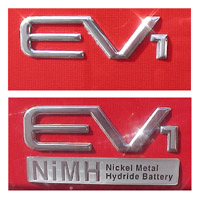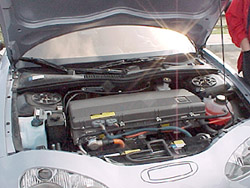|
|
Back to Main Page Extended Test Detailed Notes |
|
EV1 Chronicles

![]()
Test Driving the 1999 NiMH EV1
|
Part 1 - Dec. 5, 1998 (1999 EV1 Model Preview) Our first chance to try out a 1999 model came at the Dec. 5th combination EV1 Club meeting / 2nd EV1 birthday party / 1999 EV1 preview event along with dozens of other EV1 drivers and guests. First of all, what did the 1999 model look like? -- Virtually IDENTICAL to the 1997 model. The shape and color options are the same, and the interior is the same as the '97 (we were told a new fabric for the seats will be phased in later in the production run).

Can you tell which is the 1999 NiMH model? On the inside, all of the displays and controls appear to be identical. The only clue that the car has NiMH batteries are the larger range numbers. So if '97 owners keep their cars clean, no one will know that they don't have the latest version! (Switch the interior display from miles to KM to pretend you have NiMH batteries!)
Inside the trunk is another visible sign of the
NiMH car -- a missing 120V charger. But is the
little charger compatible at all with the NiMH
car? More on this later.
The test drive was much too short (once around the block for each of us), but our impressions agree with most of the other drivers -- the new model is quieter, handling has been significantly improved, and the air conditioning and heating effectiveness has been improved. But the most significant change, the batteries, couldn't really be tested except to say that the new car has just about the same great knock-you-back-into-your-seat kick as the '97 model.
|
||
|
Part 2 - Jan. 16, 1999 (Saturn of Santa Ana) At a mini-event to celebrate fellow club member Marc Zorn's finally getting an EV1 (after a year in the decision process), we got a second chance to try out a NiMH car. This time, we got to try it out a bit longer -- we each had a chance to take the car on the freeway for about 15 minutes. But someone before us must have REALLY been pushing the car hard, because after Jean got back from her test drive, the range estimate was showing 10 MORE miles than she started out with, despite the fact that she was trying to drive it hard! Again, the improvements in quietness, handling, rolling resistance, and air conditioning were very evident, all without hurting the car's performance. EV1 Specialist Rob Randall ran down the list of the under-the-hood changes:
|
||
|
Part 3 - Jan. 26- Feb. 2, 1999 (Extended Test) Having gotten the casual playing and poking around the car out of the way, we were now ready to see how the car (and charging) would do in "normal" use as defined by our routine commuting (keeping up with traffic at 65 MPH, or sometimes creeping along through rush hour congestion). You can jump to our detailed notes (probably mostly of interest to current EV1 drivers) but the bottom line is that GM's range estimates for the car appear to be pretty accurate for our normal commuting. It should be easy to exceed 120 miles, and fairly routine to hit 140 miles. With careful driving, it should be possible (for me) to hit 160. Any driver really trying hard for the maximum range should be able to go even farther. For any 1997 EV1 drivers wondering how far they could typically go with the NiMH version, I'd say just double your current numbers. We saw a few long charging cycles, but most seemed to complete by morning. Since it is no problem to interrupt a leveling cycle, it shouldn't put any additional restrictions on us. Because our test drives were all done during cold (or cool) periods, warm weather performance is still a question which really won't get an answer for 6 months or so. But one thing we anticipate is that we will be wanting to watch the temperature of the battery pack. This is not just out of curiosity. We can easily imagine a situation which might heat the batteries up. In this case we'd want to use the temperature to decide when to stop and take a break and try to charge up. However, since the temperature is not displayed and apparently can't be displayed without altering the display hardware, we suggest to GM that they modify their software to allow the temperature to appear on their serial data bus where it can be read and displayed using external programs some of the drivers have created. Portable Charger Compatibility One final item of note is that I did try the 120V charger on the NiMH car. It turns out that the car will charge, though as one would expect, it would take a very long time to fully charge a NiMH car if it started out empty. Occasionally I checked in on the charger to find that the charging had stopped with the red fault light on. Perhaps this was due to the car attempting to request more power when cooling. If so, then carrying around the portable charger will not do any good, so we can see why it's not included on the NiMH cars. NiMH drivers will have to bug their employers to put in real (240V) chargers as the 120V sockets won't do them any good. On the other hand I suspect most NiMH drivers won't care. Summary The 1999 EV1 is a significant improvement over the 1997 model, and as far as range is concerned, GM delivers with the NiMH battery. More is definitely better! It's time to upgrade that 486 to a Pentium! |

